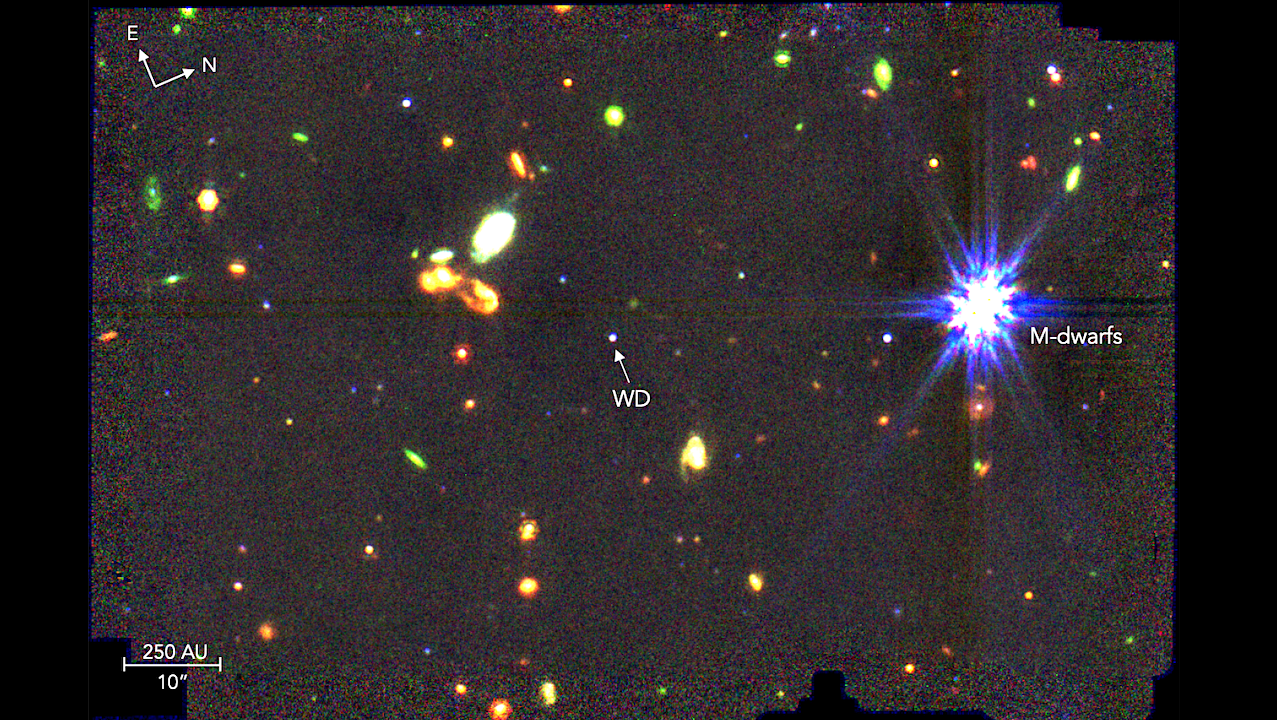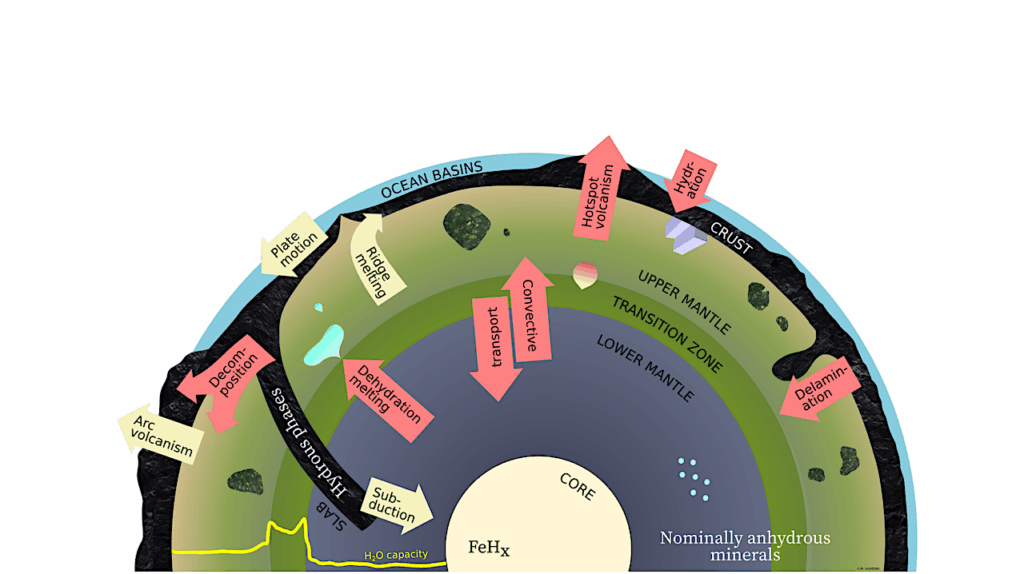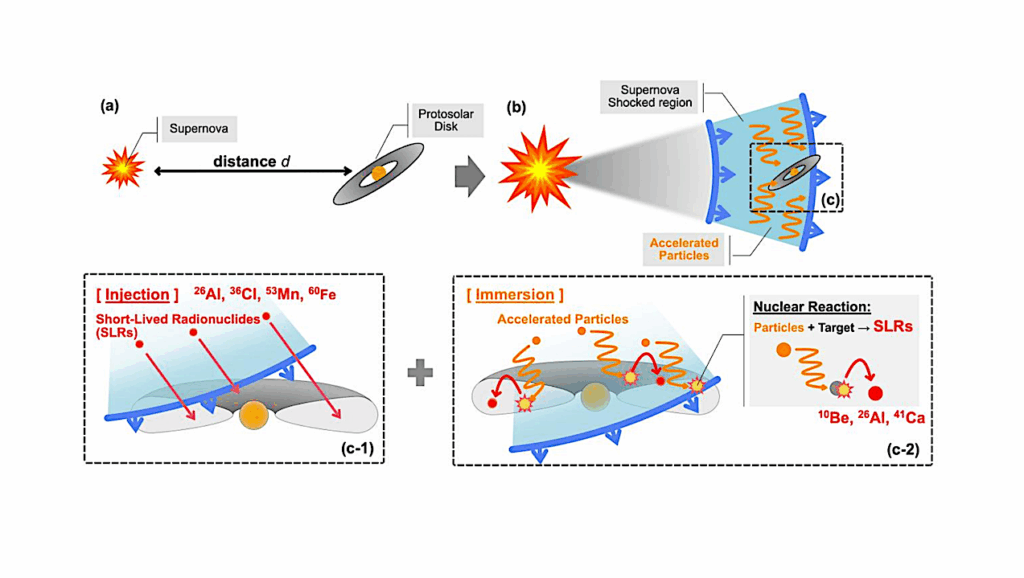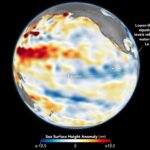Now Reading: Thermal Emission and Confirmation of the Frigid White Dwarf Exoplanet WD 1856+534b
-
01
Thermal Emission and Confirmation of the Frigid White Dwarf Exoplanet WD 1856+534b
Thermal Emission and Confirmation of the Frigid White Dwarf Exoplanet WD 1856+534b


False-color image of the WD 1856+534 system constructed using three JWST/MIRI imaging bands: F770W (7.7 µm, blue), F1500W (15 µm, green), and F1800W (18 µm, red). The FOV measures 74′′× 113′′, corresponding to 1835 AU × 2802 AU at the system’s distance of 24.8 pc. The (blended) white dwarf and planet are the bluish-white star at the center of the image. The two bright stars near the right-hand side of the field of view (FOV) are mid-M dwarf companion stars to the white dwarf, at a projected separation of 1030 AU. Numerous colorful background stars and galaxies are visible throughout the image — astro-ph.EP
We report the detection of thermal emission from and confirm the planetary nature of WD 1856+534b, the first transiting planet known to orbit a white dwarf star.
Observations with JWST’s Mid-Infrared Instrument (MIRI) reveal excess mid-infrared emission from the white dwarf, consistent with a closely-orbiting Jupiter-sized planet with a temperature of 186+6−7 K.
We attribute this excess flux to the known giant planet in the system, making it the coldest exoplanet from which light has ever been directly observed. These measurements constrain the planet’s mass to no more than six times that of Jupiter, confirming its planetary nature and ruling out previously unexcluded low-mass brown dwarf scenarios.
WD 1856+534b is now the first intact exoplanet confirmed within a white dwarf’s “forbidden zone”, a region where planets would have been engulfed during the star’s red giant phase. Its presence provides direct evidence that planetary migration into close orbits, including the habitable zone, around white dwarfs is possible.
With an age nearly twice that of the Solar System and a temperature akin to our own gas giants, WD 1856+534b demonstrates JWST’s unprecedented ability to detect and characterize cold, mature exoplanets, opening new possibilities for imaging and characterizing these worlds in the solar neighborhood.
Mary Anne Limbach, Andrew Vanderburg, Ryan J. MacDonald, Kevin B. Stevenson, Sydney Jenkins, Simon Blouin, Emily Rauscher, Rachel Bowens-Rubin, Elena Gallo, James Mang, Caroline V. Morley, David K. Sing, Christopher O’Connor, Alexander Venner, Siyi Xu
Comments: ApJL in press
Subjects: Earth and Planetary Astrophysics (astro-ph.EP); Solar and Stellar Astrophysics (astro-ph.SR)
Cite as: arXiv:2504.16982 [astro-ph.EP] (or arXiv:2504.16982v1 [astro-ph.EP] for this version)
https://doi.org/10.48550/arXiv.2504.16982
Focus to learn more
Submission history
From: Mary Anne Limbach
[v1] Wed, 23 Apr 2025 18:00:00 UTC (4,223 KB)
https://arxiv.org/abs/2504.16982
Astrobiology,
Stay Informed With the Latest & Most Important News
Previous Post
Next Post
-
 012024 in Review: Highlights from NASA in Silicon Valley
012024 in Review: Highlights from NASA in Silicon Valley -
 02Panasonic Leica Summilux DG 15mm f/1.7 ASPH review
02Panasonic Leica Summilux DG 15mm f/1.7 ASPH review -
 03From Polymerization-Enabled Folding and Assembly to Chemical Evolution: Key Processes for Emergence of Functional Polymers in the Origin of Life
03From Polymerization-Enabled Folding and Assembly to Chemical Evolution: Key Processes for Emergence of Functional Polymers in the Origin of Life -
 04How New NASA, India Earth Satellite NISAR Will See Earth
04How New NASA, India Earth Satellite NISAR Will See Earth -
 05And Thus Begins A New Year For Life On Earth
05And Thus Begins A New Year For Life On Earth -
 06Astronomy Activation Ambassadors: A New Era
06Astronomy Activation Ambassadors: A New Era -
07SpaceX launch surge helps set new global launch record in 2024




















